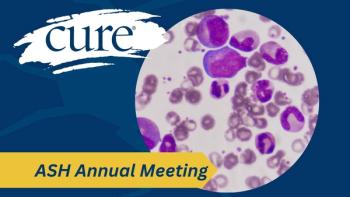
Imlunestrant Alone or With Verzenios Improved PROs in Advanced Breast Cancer
Key Takeaways
- Imlunestrant, alone or with Verzenios, improved patient-reported outcomes in ER-positive, HER2-negative advanced breast cancer post-endocrine therapy.
- In patients with an ESR1 mutation, imlunestrant showed better global health status/quality of life scores than standard endocrine therapy.
Imlunestrant alone or in combination with Verzenios improved patient-reported outcomes in ER+, HER2– advanced breast cancer following endocrine therapy.
Imlunestrant alone or in combination with Verzenios (abemaciclib) improved patient-reported outcomes among those with estrogen receptor (ER)–positive, HER2-negative advanced breast cancer who progressed after endocrine therapy.
Notably, these data were derived from the phase 3 EMBER-3 trial presented at the 2025 ASCO Annual Meeting. In patients with an ESR1 mutation, based on changes in baseline in the EORTC QLQ-C30 global health status/quality of life score, treatment with imlunestrant was favored compared with standard of care endocrine therapy. At treatment cycle seven, the difference between groups was 9.9 points. The global health status/quality of life score was typically maintained across both treatment arms.
In patients with an ESR1 mutation, the median time to deterioration of global health status/quality of life score with imlunestrant was 5.6 months, with 53 events, compared with 3.8 months and 50 events, with endocrine therapy. The investigators noted that estimates were limited by a high rate of censoring.
Additionally, in patients with an ESR1 mutation, overall global health status/quality of life score and functional domains remained consistent. Imlunestrant was superior regarding the physical, role, social, emotional, and cognitive functional domains. Regarding symptom domains, worse scores were observed with endocrine therapy for fatigue, pain, dyspnea, insomnia and appetite loss; worse scores were observed with imlunestrant for nausea/vomiting, constipation, and diarrhea. It was noted that symptom domains were broadly similar between treatment groups.
In all patients, the overall changes in global health status/quality of life score and functional domains were typically maintained across all treatment arms. In order from worst to best, the mean change from baseline for global health status/quality of life score was imlunestrant plus Verzenios, endocrine therapy and imlunestrant; for physical function, social function, emotional function and cognitive function, it was the same, and for role function, it was endocrine therapy, imlunestrant plus Verzenios, and imlunestrant.
Regarding symptom domains, imlunestrant plus Verzenios demonstrated clinically meaningful worse scores regarding nausea/vomiting and diarrhea. The average proportion of time with “frequent” or “almost constant” diarrhea was 22% with imlunestrant plus Verzenios, 3% with imlunestrant, and 2% with endocrine therapy.
“Consistent with the primary results from EMBER-3, these patient-reported outcomes results reinforce the benefit of imlunestrant, as monotherapy or combined with Verzenios, as an all-oral targeted therapy option after progression on [endocrine therapy] for patients with ER-positive, HER2-negative [advanced breast cancer],” wrote lead study author Dr. Giuseppe Curigliano, a professor of medical oncology at the University of Milano, and of the European Institute of Oncology, National Institute of Hospitalization and Scientific Care in Milano, Italy, and coauthors, in the presentation.
The trial enrolled approximately 859 patients who were randomly assigned to receive either imlunestrant monotherapy (327 patients), imlunestrant plus Verzenios (208 patients) or endocrine therapy (324 patients). Imlunestrant was given at 400 milligrams (mg) every day in both groups; Verzenios was given at the labeled dose; and endocrine therapy, which was the investigator’s choice between Faslodex (fulvestrant) or Aromasin (exemestane), was also given at the labeled dose.
Eligible patients had ER-positive, HER2-negative advanced disease. Regarding prior therapies, in the adjuvant setting, patients had recurrence on or within 12 months of completion of an aromatase inhibitor with or without a CDK4/6 inhibitor; for advanced breast cancer, patients had progression on a first-line aromatase inhibitor with or without a CDK4/6 inhibitor and no other therapy for advanced breast cancer.
The trial’s primary end points were investigator-assessed progression-free survival across all treatment groups. Secondary end points included overall survival, blinded independent committee review-assessed PFS, overall response rate, and safety; exploratory end points were patient-reported outcomes.
The patient-reported outcomes measures used and their respective schedules are as follows: the EORTC QLQ-C30 global health status/quality of life score, function domains, and symptom domains were assessed on day one and then every eight weeks after with short-term follow-up; the EORTC IL-19 physical functioning was assessed every eight weeks opposite the EORTC QLQ-C30; the Patient-reported Outcomes version of the Common Terminology Criteria for Adverse Events (a patient-reported outcome measurement system developed by the National Cancer Institute to capture symptomatic adverse events in patients on cancer clinical trials; PRO-CTCAE) for frequency of diarrhea was assessed on day one then every week after with short-term follow-up; and the PRO-CTCAE injection site reaction occurrence was assessed every week of cycle one then the first two weeks of all other cycles.
It was reported that 72% of patients receiving Faslodex experienced injection site reaction at any time of treatment; 20% of them had an incidence of less than 25%, 32% had an incidence from 25% to 50%, 30% had an incidence from 50% to 75%, and 17% had an incidence of greater than 75%.
The median investigator-assessed progression-free survival, in all patients, was 9.4 months with imlunestrant plus Verzenios and 5.5 months with imlunestrant alone. In patients with an ESR1 mutation, the median progression-free survival was 5.5 months with imlunestrant alone versus 3.8 months with endocrine therapy.
Regarding safety, treatment-emergent side effects of any grade occurred in 83% of patients with imlunestrant, 98% of patients with imlunestrant plus Verzenios, and 84% of patients with endocrine therapy; of grade 3 or higher, treatment-emergent side effects occurred in 17%, 49%, and 21%, respectively.
In patients with imlunestrant, dose reductions, treatment discontinuations, and death due to side effects occurred in 2%, 4%, and 2%; in patients with imlunestrant plus Verzenios, they occurred in 39%, 6%, and 1%, respectively; and in patients with endocrine therapy, they occurred in 0%, 1%, and 1%.
Reference
“Patient-reported outcomes (PROs) in patients with ER+, HER2- advanced breast cancer (ABC) treated with imlunestrant, investigator’s choice standard endocrine therapy, or imlunestrant + abemaciclib: Results from the phase III EMBER-3 trial" by Dr. Curigliano G, et al., Journal of Clinical Oncology.
For more news on cancer updates, research and education, don’t forget to





